This Horticulture Innovation Lab webinar provides an overview of the importance of good postharvest handling globally and introduces a new postharvest training series. This curriculum includes beginning, intermediate, and advanced levels of narrated powerpoint lessons on topics ranging from posthavest basics, water sanitation to food safety, storage of horticultural crops, and water loss of fruits and vegetables. This was the eighth webinar in the Horticulture for Development Professional Series, held live on September 12, 2019.
Presenters included:
- Elizabeth Mitcham, director of the Horticulture Innovation Lab and postharvest physiologist with UC Davis
- Jeffrey Brecht, professor of postharvest biology, University of Florida
- Mark Ritenour, professor of horticultural sciences, University of Florida
Mitcham provided an overview of the importance of postharvest handling for horticulture and how reducing losses can improve food security. Brecht and Ritenour introduced the postharvest training for horticultural crops and showed how the lessons build off of each other becoming more complex across the three levels.
This summary includes the recorded webinar video presentation and the presenter's slides.
Reducing postharvest losses improving food security
When it comes to postharvest management, fruits and vegetables are highly perishable so good practices and handling are important. Fruits and vegetables have a very high water content compared to other crops and are also a good source of nutrients. Due to their high water content, they can be easily damaged and deteriorate quickly.
Due to these characteristics, postharvest losses of fruits and vegetables can be significant. Mitcham showed a table of estimated postharvest losses of fresh produce, with differences visible between developed and developing countries. Developed countries experience lower postharvest losses from horticultural production to retail sites, but higher losses at retail, food service, and consumer sites. Developing countries represent the opposite trend, where postharvest losses are greater in relation to production.
Reducing postharvest losses provides an opportunity to improve food security. High losses of fruits and vegetables reduces the availability of nutritious produce for consumption. It also causes a loss of investment as farmer resources and investments used to grow fruits and vegetables are lost when fresh produce is not sold nor eaten. Improving postharvest handling and reducing losses is critical to food security. With more produce available to sell, farmers can also receive greater returns and greater availability can reduce prices for consumers.
Common causes of postharvest losses
Postharvest losses in developing countries can be attributed to several factors. High temperatures and sun exposure after harvest are a common cause for deterioration of fruits and vegetables. Lack of proper shading and cooling mechanisms lead to increased ripening and decay. High temperatures also contribute to water loss which can result in postharvest losses. Improper packaging and storage can physically damage fruits and vegetables.
New technologies and innovations can support the improvement of postharvest handling, but many barriers prevent adoption. Some barriers to adoption include lack of market incentives, lack of capital, resource availability, lack of information, and policies that do not promote best practices.
Increased recognition of the importance of postharvest losses has been one of the main drivers of adopting good postharvest handling practices. A recognized need for postharvest information also led to the creation of this postharvest training curriculum for horticultural crops. Providing farmers with useful information and practical training can result in improving postharvest practicies, reducing losses, and improving food security.
Postharvest training curriculum for horticultural crops
This three-level training series was originally designed through a Horticulture Innovation Lab project led by the University of Florida and a team of postharvest experts. The training series was originally created for farmers and audiences in Latin America, but lessons are widely applicable to small-scale farmers elsewhere in the world.
Each level is intended for a particular audience based on their experience with postharvest handling of horticultural crops and the extent to which they are selling their products in different types of markets.
- The first level is geared towards subsistence farmers who are interested in selling some of their crops at local markets or roadside stands, but have little or no background in postharvest management.
- The second level was designed for farmers who are already selling their fruits and vegetables and are looking to increase the markets they sell to, in terms of distance and size of the markets.
- The third level is focused on farmers with more extensive experience selling their crops and want to improve their handling practices for export.
Each level builds off of each other with increasing complexity of the information covered. Ten topics are included in each level with new information added as they progress in difficulty. The ten topics in each level include:
- Postharvest basics
- Sorting and grading
- Quality measurement
- Curing underground storage organs
- Water sanitation and food safety
- Types of packaging
- Cooling and temperature management
- Storage practices
- Transportation
- Water loss
Each lesson is structured as a narrated powerpoint in which a postharvest expert talks participants through best practices in that topic. All lessons are available via Internet access; no downloads are required. Users can control the pace at which they progress through each lesson, pausing and skipping sections as needed.
Brecht and Ritenour played several examples of the lessons to show how each levels builds off the previous one in difficulty. They also showed how to use access notes and search each training.

